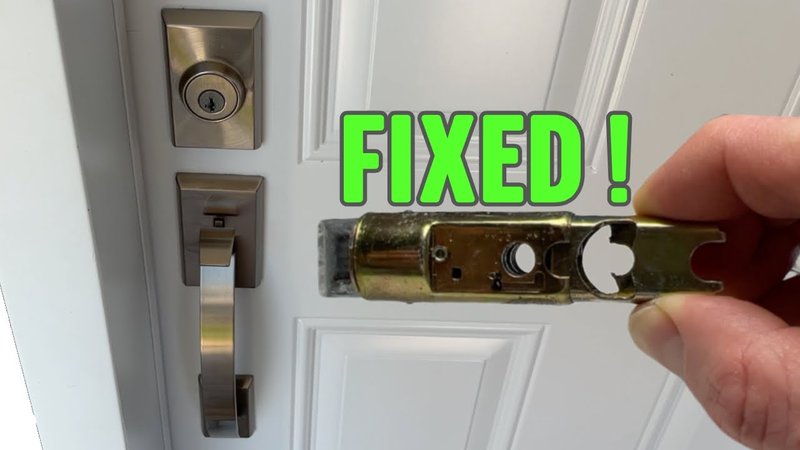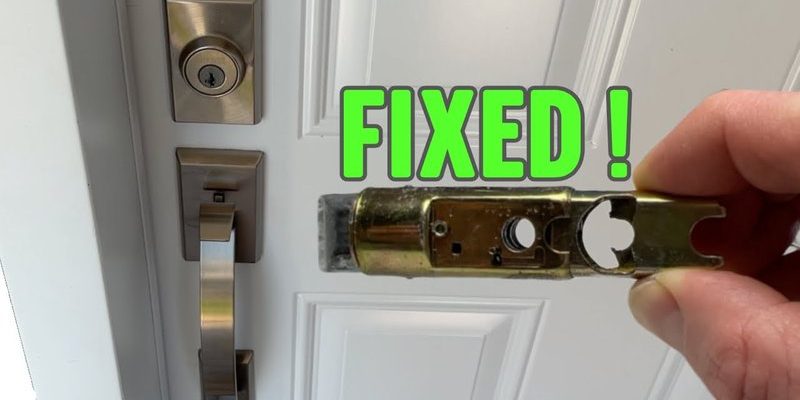
But when your handleset is tough to turn, it’s usually a sign that something’s out of sync inside the mechanism. Maybe it’s a worn-out latch, old lubrication gumming up the works, or just a bit of misalignment after a DIY installation. Before you rush to replace your entire lock, let’s walk through what actually causes this, why it matters, and how you can fix it step by step. Honestly, most of these fixes don’t need special tools or a locksmith—just a little patience and the right know-how.
Common Causes of a Stiff or Difficult Handleset
Let’s be real: a handleset isn’t exactly a high-tech device. It’s mostly mechanical, made up of moving parts that need to dance together smoothly. When turning the handle feels like a workout, there’s usually a mechanical reason behind it. Most often, it’s because a part inside your handleset is getting stuck, forced, or blocked in some way.
Here’s the thing: handlesets are exposed to all sorts of everyday abuse—humidity, dust, temperature swings, and plain old wear and tear. Over time, the internal components (like the latch and spindle) just don’t move as easily as they once did. If you have a brand like Kwikset, Yale, or Schlage, these problems will show up in similar ways, though the setup inside each model can be a bit different. What almost always happens is that either the latch is sticking, the mounting screws have loosened, or there’s gunk in the way.
*You might be wondering if this is just a sign your lock is wearing out.* Not always! Often, a simple battery of troubleshooting steps—like adjusting the plate, tightening a few screws, or adding the right lubricant—can get things back to normal. So, don’t toss the set just yet.
Checking for Obvious Installation or Alignment Issues
Let me explain: If your handleset was recently installed or adjusted (even if that was just slamming the door one too many times), it might not be properly aligned with your door and frame. Handlesets need everything lined up—down to the millimeter—so the latch doesn’t catch or drag.
First, open the door and look at how the latch lines up with the strike plate on the door frame. Is it centered in the opening, or does it scrape the edge? Even a slight misalignment can make it feel like you need to use a ton of force to turn the handle. If you see marks where the latch is hitting the metal or wood, that’s a good sign your alignment is off.
- Tighten the mounting screws on both the handleset and the strike plate. Loose screws can let things shift out of place.
- Adjust the strike plate by loosening the screws, moving it slightly, and tightening it again. Sometimes, just a millimeter makes a world of difference.
- Check for warping on older wooden doors, especially if they’ve seen a few winters or humidity swings.
If everything seems aligned but the handle’s still stiff, don’t worry. There are other places to check.
Inspecting the Internal Mechanism for Wear or Damage
Here’s where a little detective work comes in. The inside of your handleset is a set of simple gears and levers—nothing fancy, but they have to move freely. Over time, parts like the spindle (the rod connecting the handle through the door) or the latch itself can bend, wear, or break.
To check, you’ll need to carefully remove the handleset—usually, this just means unscrewing a couple of mounting screws on the inside. With the set off, take a good look at the moving parts. Is anything bent, cracked, or loose? Try turning the handle while it’s off the door. If it turns easily now, the issue is likely with your door alignment, not the mechanism. If it’s still stiff, you’ve likely found your culprit.
Sometimes, you’ll see obvious problems, like a worn-down spindle or a latch that doesn’t spring back. If that’s the case, most brand-name sets (like Schlage or Baldwin) sell replacement parts, so you don’t have to buy a whole new handleset. Swapping these out is usually just a matter of removing the old part and sliding the new one in.
Tip: Take a few photos of the setup before you pull things apart. Trust me, your future self will thank you when it’s time to put everything back together.
Lubricating the Handleset to Restore Smooth Movement
Honestly, old or dried-up lubricant is one of the sneakiest causes of a stubborn door handle. The metal parts inside a handleset need a thin layer of grease or graphite to slide against each other easily. Over time, dust, dirt, and weather can turn that grease into sticky gunk, making the handle hard to turn.
After checking for obvious damage, grab a can of graphite spray or a lock-specific lubricant—avoid WD-40 for most door locks, since it can attract more grime in the long run. With the handleset removed or open, spray a small amount into all moving parts, especially around the spindle and latch. Then, work the handle back and forth a few times to spread the lubricant.
- Don’t overdo it—a little goes a long way.
- Wipe away any extra lubricant to avoid attracting dust.
- If you don’t want to remove the set, you can often spray lubricant right into the latch opening with the door open.
If your handle feels significantly smoother after this, you’ve likely solved the problem. If not, there are a couple more areas to check before calling in backup.
Testing the Latch and Deadbolt Function Separately
You might be wondering: is the problem with the handle itself, or with the lock? Many handlesets have both a latch (operated by the handle) and a deadbolt (operated by the key or thumbturn). Sometimes, a jammed deadbolt will make the whole thing feel stuck, even if the handle is fine.
Here’s how to test them separately:
- With the door open, try turning the handle. If it moves easily now, your issue is likely with the alignment of the latch and strike plate (like we talked about earlier).
- Turn the deadbolt without touching the handle. If it sticks or feels gritty, it may need lubrication or replacement on its own.
- Try operating both at the same time. Sometimes, an issue with one mechanism can “sync” and make the other feel stuck.
If you find the deadbolt or latch is the only part having trouble, focus your troubleshooting there—sometimes this means disassembling just that part for a closer look.
Comparing Universal Handlesets to Brand-Specific Models
Not all handlesets are created equal. Universal handlesets are designed to fit a range of doors and brands, but because they’re a “one-size-fits-most” solution, sometimes the fit isn’t perfect. If you’ve installed a universal handleset, you might notice extra stiffness or wiggle, especially if the internal parts aren’t perfectly aligned with the holes and thickness of your door.
Brand-specific models—like those from Kwikset, Schlage, or Emtek—are designed for their own systems, so everything generally lines up more smoothly and the parts fit together just right. Yes, they can cost a bit more, but you’re less likely to end up with these kinds of sticky or stiff handles.
If you’ve recently switched from a universal to a brand-specific handleset (or vice versa) and noticed new problems, double-check the fit of all the components—sometimes even the backset (the distance from the edge of the door to the center of the bore hole) can cause subtle binding that leads to extra force being needed.
Pro insight: Whenever possible, stick to the same brand for replacement parts and handlesets. You’ll have a much easier time with installation, troubleshooting, and future repairs.
When to Replace the Handleset or Call a Locksmith
Let’s be honest—sometimes a handleset is just at the end of its life. If you’ve tried all the troubleshooting steps above and your handle still takes Herculean strength to turn, it might be time for a new set. Signs that replacement is needed include parts that are physically cracked, rusted, or won’t spring back no matter what you do.
If you’re not comfortable taking things apart, or if you suspect there’s a more complicated problem (like a door that’s badly warped or a lock that’s jammed beyond repair), there’s no shame in calling a professional locksmith. In fact, a good locksmith can often spot and fix the problem in less time than it’ll take you to watch a half-dozen troubleshooting videos.
You might be surprised to find that a full handleset replacement isn’t as costly or complicated as it seems. Many modern sets are designed for easy installation and even come with detailed instructions. If you go this route, take your time, follow the steps closely, and don’t be shy about reaching out for help if you get stuck.
Wrapping Up: Keeping Your Handleset Working Smoothly
Fixing a handleset that requires excessive force to turn can feel like a hassle at first, but most issues boil down to alignment, lubrication, or a worn-out part. By checking each component carefully, making small adjustments, and giving your handleset a little TLC, you’ll usually get things moving smoothly again—without a locksmith bill.
Here’s the thing: regular maintenance goes a long way. Every few months, give your handleset a quick once-over—tighten the screws, check the alignment, and add a dash of lubricant if things start to feel gritty. That way, you’ll avoid most of the headaches before they start, and your front door will always open with a satisfying, smooth turn. If you ever run into a problem that feels out of your depth, just remember—help is only a call (or a quick YouTube tutorial) away.
